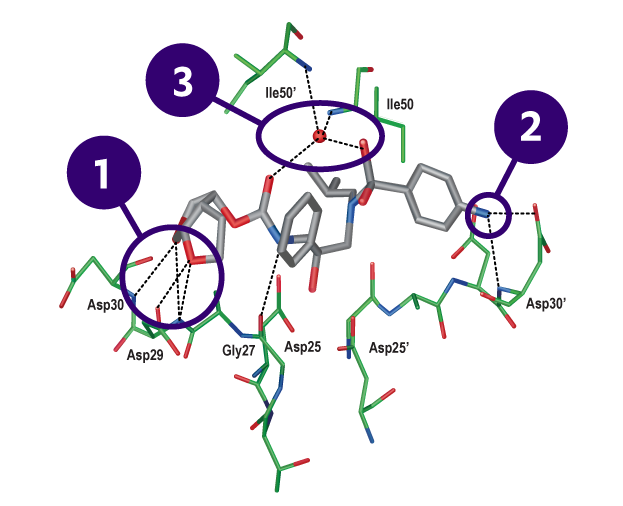Binding Affinity
PREZCOBIX® Contains Darunavir, Which Closely and Tightly Binds to HIV-1 Protease1,2

Adapted with permission from Ghosh AK et al. Angew Chem Int Ed. 2012;51:1778-1802.
1
-
Tightly binds to HIV-1 protease1
- Fits closely in the substrate pocket2
- Has a dissociative half-life of >240 hours1
2
- Enhanced binding affinity is related to its ability to form an extensive network of hydrogen-bonding interactions within the HIV-1 protease active site2
- Can sustain a substantial decrease in its binding constant without compromising its activity entirely3
3
- Because of its molecular flexibility, darunavir can adapt itself to the changing shape of a mutant HIV protease4
- Tight interactions with backbone atoms were consistently observed with mutant proteases5
References: 1. Diernyck I, De Wit M, Gustin E, et al. Binding kinetics of darunavir to human immunodeficiency virus type 1 protease explain the potent antiviral activity and high genetic barrier. J Virol. 2007;81:13845-13851. 2. Ghosh AK, Anderson DD, Weber IT, Mitsuya H. Enhancing protein backbone binding—a fruitful concept for combating drug-resistant HIV. Angew Chem Int Ed. 2012;1778-1802. 3. King NM, Prabu-Jeyabalan M, Nalivaika EA, et al. Structural and thermodynamic basis for the binding of TMC114, a next-generation human immunodeficiency virus type 1 protease inhibitor. J Virol. 2004;78:12012-12021. 4. Tremblay CL. Combating HIV resistance—focus on darunavir. Ther Clin Risk Manag. 2008;4:759-765. 5. Ghosh AK, Chapsal BD, Weber IT, Mitsuya H. Design of HIV protease inhibitors targeting protein backbone: an effective strategy for combating drug resistance. Accounts Chem Res. 2008;41:78-86.
